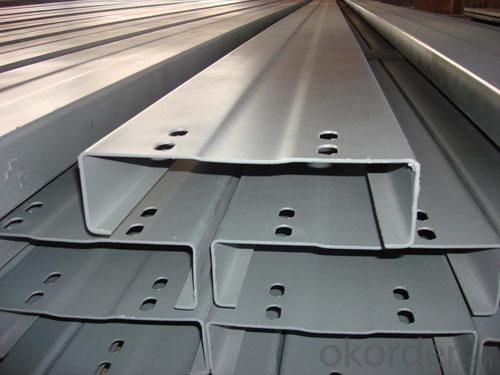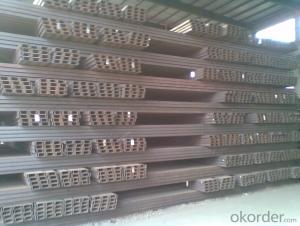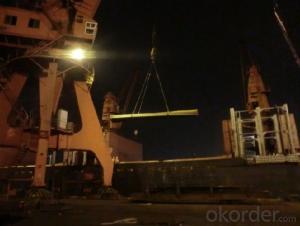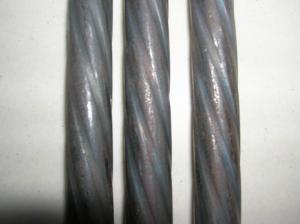MS C Channel Bar
- Loading Port:
- Tianjin Port,China
- Payment Terms:
- TT or LC
- Min Order Qty:
- 20Tons m.t.
- Supply Capability:
- 1000 Tons Per Month m.t./month
OKorder Service Pledge
OKorder Financial Service
You Might Also Like
Specifications of MS C Channel Bar:
1.We supply high quality MS C Channel Bar at reasonable price, including Chinese standard, Japanese standard and so on.
Standard | GB/JIS/EN/ASTM/DIN |
Material Grade | Q235B,Q235,Q345,Q345B,SS400,S235JRG1,A36,ST37-2 |
Technique: | Cold Rolled |
Sizes as per chinese standard: |
80×40×20×2.5 - 180×60×20×2.5
|
Sizes as per Japanese standard: |
180×60×20×3 – 300×80×20×3 |
Length: | 6meter, 9meter, 12meter |
Note: we are also competent to provide our customers other MS C Channel Bar based on other sizes according to customer’s requirements.
2. The detailed sections of MS C Channel Bar as per GB standard.Just as followings in the table-1:
Size | Weight(kg/m) | Size | Weight(kg/m) |
80×40×20×2.5 | 3.925 | 180×60×20×3 | 8.007 |
80×40×20×3 | 4.71 | 180×70×20×2.5 | 7.065 |
100×50×20×2.5 | 4.71 | 180×70×20×3 | 8.478 |
100×50×20×3 | 5.652 | 200×50×20×2.5 | 6.673 |
120×50×20×2.5 | 5.103 | 200×50×20×3 | 8.007 |
120×50×20×3 | 6.123 | 200×60×20×2.5 | 7.065 |
120×60×20×2.5 | 5.495 | 200×60×20×3 | 8.478 |
120×60×20×3 | 6.594 | 200×70×20×2.5 | 7.458 |
120×70×20×2.5 | 5.888 | 200×70×20×3 | 8.949 |
120×70×20×3 | 7.065 | 220×60×20×2.5 | 7.4567 |
140×50×20×2.5 | 5.495 | 220×60×20×3 | 8.949 |
140×50×20×3 | 6.594 | 220×70×20×2.5 | 7.85 |
160×50×20×2.5 | 5.888 | 220×70×20×3 | 9.42 |
160×50×20×3 | 7.065 | 250×75×20×2.5 | 8.634 |
160×60×20×2.5 | 6.28 | 250×75×20×3 | 10.362 |
160×60×20×3 | 7.536 | 280×80×20×2.5 | 9.42 |
160×70×20×2.5 | 6.673 | 280×80×20×3 | 11.304 |
160×70×20×3 | 8.007 | 300×80×20×2.5 | 9.813 |
180×50×20×2.5 | 6.28 | 300×80×20×3 | 11.775 |
180×50×20×3 | 7.536 | ||
180×60×20×2.5 | 6.673 |
Table-1
3. The chemical composition of MS C Channel Bar according to Q235B is shown in Table-2.
Alloy No | Grade | Element(%) | ||||
C | Mn | S | P | Si | ||
Q235 | B | 0.12-0.20 | 0.3-0.7 | ≦0.045 | ≦0.045 | ≦0.3 |
Table-2
Note: we are able to present our customers relevant SGS test report for chemical composition of MS C Channel Bar.
4. The mechanical property of MS C Channel Bar according to Q235B is shown in Table-3-1 and Table-3-2
Alloy No | Grade | Yielding Strength Point(Mpa) | |||
Thickness(mm) | |||||
≦16 | >16-40 | >40-60 | >60-100 | ||
≧ | |||||
Q235 | B | 235 | 225 | 215 | 205 |
Table-3-1
Alloy No | Grade | Tensile Strength(Mpa) | Elongation After Fracture(%) | |||
Thickness(mm) | ||||||
≦16 | >16-40 | >40-60 | >60-100 | |||
≧ | ||||||
G235 | B | 375-500 | 26 | 25 | 24 | 23 |
Table-3-2
Note: we are able to present our customers relevant SGS test report for mechanical property of MS C Channel Bar as customer’s request.
Applications of MS C Channel Bar:
The MS C Channel Bar can be applied to construction of warehouses, workshops, sport stadiums and car parks etc.The hot rolled channel steel belongs to carbon structural steel which is applied to in the field of construction and machinery.In details, the hot rolled channel steel is usually used for arch-itechtural structure, and they could be welded in order to support or hang a vari-ety of facilities. They are also usually used in combination with I beam. Generally,the hot rolled channel steel we supply must possess perfect welding property, riveting property and mechanical property and so on.
Package & Delivery of MS C Channel Bar:
1.The hot rolled channel steel will be packed in bundle with steel wire at each end of every bundle and color marking in order to help the customer to recognize his goods more easily at sight.
2. And the hot rolled channel steel could be loaded into 20ft or 40ft container, or by bulk cargo.If the weight of each bundle reaches more than 3.5 mt, the loading by break bulk cargo should be choosed.When the weight of each bundle reaches less than 3mt, the loading by container should be choosed.
3.As for the transportaion from mill to loading port, the truck will be usually used. And the maximum quantity for each truck is 40mt.
4.All in all, we could do in accordance with customer's request.
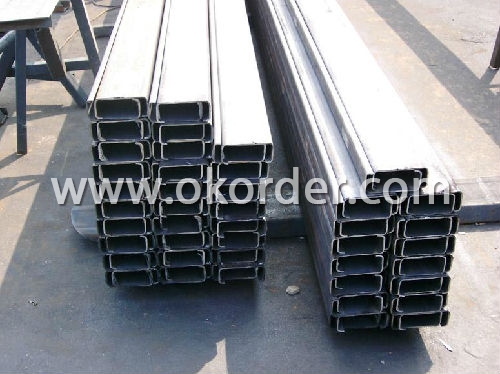
Production Flow of MS C Channel Bar:
1.The steel billet shall be heated in the high temperature furnace.
2. The heated steel billet shall be rolled five to nine times with the aim of shaping the general figure of steel u channel.
3. The hot rolled channel steel should be put onto the cooling bed to make the temperature low.
4. The channel steel should be straighted on the straightener.
5. The straighted channel steel will be cut into meters by saw, as per customer's requirements.

- Q: Does anyone know how to calculate the volume of channel steel?!
- 1, check out the books on Design of cross-sectional area multiplied by the length of2, if there is in kind, called weight divided by 7.85
- Q: Are steel channels suitable for supporting overhead equipment or structures?
- Yes, steel channels are suitable for supporting overhead equipment or structures. Steel channels are often used in construction and engineering projects due to their strength and durability. They provide a stable and reliable support system for overhead equipment or structures, ensuring safety and stability. Steel channels are designed to withstand heavy loads, making them ideal for supporting equipment or structures that require a strong and sturdy foundation. Additionally, steel channels can be customized to meet specific project requirements, such as size, shape, and length, further enhancing their suitability for supporting overhead equipment or structures.
- Q: How do steel channels compare to I-beams?
- Steel channels and I-beams are both structural components commonly used in construction and engineering projects. However, they differ in their shapes and load-bearing capacities. Steel channels have a U-shaped cross-section, while I-beams have an I-shaped cross-section. I-beams are generally stronger and more rigid than steel channels, making them suitable for supporting heavy loads over long spans. On the other hand, steel channels are often used for lighter applications, such as framing, bracing, and support in smaller structures. Ultimately, the choice between steel channels and I-beams depends on the specific requirements and load-bearing needs of the project.
- Q: Channel 12, span 5 meters, how much weight can be carried?
- 8.5 meters tall, *11.8, inside the half second layer, 3 wall, 11.8 meters side horizontal pull a beam (bearing), I would like to ask how much channel (GB)
- Q: Can steel channels be used for scaffolding?
- Yes, steel channels can be used for scaffolding.
- Q: What are the cost considerations when using steel channels?
- When using steel channels, there are several cost considerations that need to be taken into account. Firstly, the cost of the steel itself is an important factor. The price of steel can vary depending on factors such as the grade and quality of the steel, as well as market conditions. It is important to consider the cost of the steel channels in relation to the budget and overall project costs. Another cost consideration is the fabrication and installation of the steel channels. Depending on the complexity of the design and the specifications required, the fabrication and installation costs can vary. It is essential to carefully evaluate these costs and ensure they are within the project budget. Additionally, transportation costs should be considered. Steel channels can be heavy and require special handling and transportation. The distance to the project site and the logistics involved in transporting the steel channels can impact the overall cost. Maintenance and durability are also important cost considerations. Steel channels are known for their durability and long lifespan, which can reduce maintenance and replacement costs over time. However, regular maintenance and proper care are still necessary to ensure the longevity of the steel channels. Lastly, it is crucial to consider any additional costs associated with steel channels, such as coatings or finishes. Depending on the application and environmental conditions, certain coatings or finishes may be required to protect the steel from corrosion or other factors. These additional costs should be factored into the overall budget. In conclusion, the cost considerations when using steel channels include the cost of the steel itself, fabrication and installation costs, transportation costs, maintenance and durability, as well as any additional costs associated with coatings or finishes. It is important to carefully evaluate these factors to ensure that the use of steel channels aligns with the project's budget and requirements.
- Q: The following steel is not section bar, is it? A. thread steel, B. steel pipe, C. track, D. channel steel
- The thread steel belongs to the small section steel, the track and the channel steel belong to the large section steel.According to the shape of the cross-section, the steel is generally divided into profiles, plates, pipes and metal products in four categories.Therefore, the steel pipe belongs to the pipe, not the profile.
- Q: What are the common methods of joining steel channels together?
- Steel channels can be joined together using various methods, including welding, bolting, riveting, and adhesive bonding. Welding is a widely used technique for joining steel channels. It involves melting the edges of the channels and fusing them together using a welding rod or electrode. This creates a strong and permanent bond. Welding is particularly effective for thick steel channels, offering high strength and durability. Bolting, on the other hand, utilizes bolts, nuts, and washers. Holes are drilled through the channels, and bolts are inserted and tightened with nuts on the opposite side. Bolting is a versatile method that allows for easy disassembly and reassembly of the channels, making it suitable for applications requiring frequent maintenance or adjustments. Riveting, another method, employs metal rivets to connect steel channels. Holes are drilled through the channels, and a rivet is inserted and secured by hammering or pressing. Riveting creates a robust and permanent connection, commonly used in structural applications like bridges and buildings. Adhesive bonding involves the use of industrial-grade adhesives to join steel channels. The adhesive is applied to the surfaces of the channels, and pressure is applied for proper adhesion. While adhesive bonding can provide a strong and durable bond, it is crucial to choose the appropriate adhesive based on the specific steel and application requirements. The selection of the joining method depends on factors such as the application, required strength, ease of assembly and disassembly, as well as the available equipment and resources. Each method has its advantages and limitations.
- Q: Are steel channels cost-effective?
- Yes, steel channels are generally considered cost-effective. Steel is known for its durability, strength, and longevity, which makes it a reliable material for various construction and industrial applications. Steel channels are designed to provide structural support, distribute loads, and enhance stability in buildings and infrastructure projects. Additionally, steel channels are readily available and can be easily fabricated to meet specific project requirements. While the initial cost of steel may be higher than other materials, its long-term benefits, such as low maintenance and resistance to corrosion, make it a cost-effective choice in the long run.
- Q: What is the difference between channel steel and angle steel?
- The cross section of the channel steel is concave, and the cross section of the angle steel is L to form 90 degrees angle, but the length of the two sides is equal. Standard Specification for steel: height (mm) * leg width (mm) * * waist thickness (mm) * length (M) representation, e.g., 75 * 40 * 4.5 * 6.
1. Manufacturer Overview
| Location | Tianjin,China |
| Year Established | 2006 |
| Annual Output Value | Above US$ 500 Million |
| Main Markets | China; Middle East; Southeast Asia; South America |
| Company Certifications |
2. Manufacturer Certificates
| a) Certification Name | |
| Range | |
| Reference | |
| Validity Period |
3. Manufacturer Capability
| a) Trade Capacity | |
| Nearest Port | Tianjin |
| Export Percentage | 40%-60% |
| No.of Employees in Trade Department | 11-20 People |
| Language Spoken: | English; Chinese |
| b) Factory Information | |
| Factory Size: | Above 50,000 square meters |
| No. of Production Lines | Above 3 |
| Contract Manufacturing | materials for processing; OEM Service Offered |
| Product Price Range | Average |
Send your message to us
MS C Channel Bar
- Loading Port:
- Tianjin Port,China
- Payment Terms:
- TT or LC
- Min Order Qty:
- 20Tons m.t.
- Supply Capability:
- 1000 Tons Per Month m.t./month
OKorder Service Pledge
OKorder Financial Service
Similar products
Hot products
Hot Searches
Related keywords




